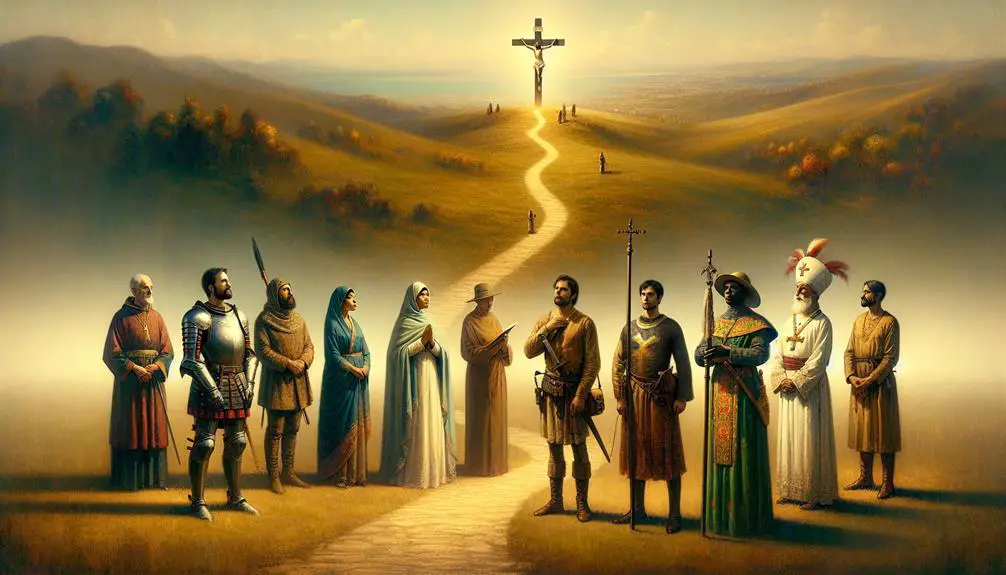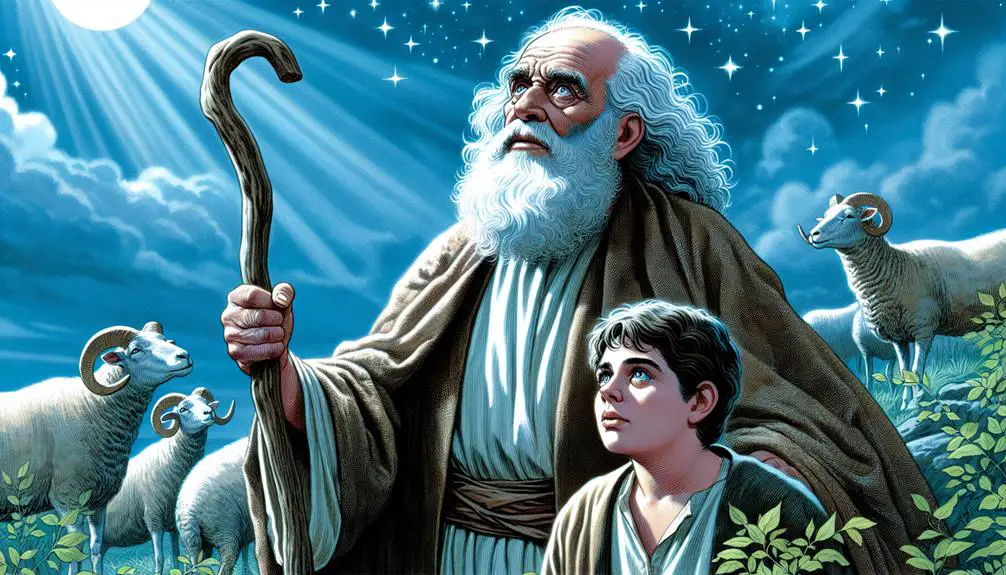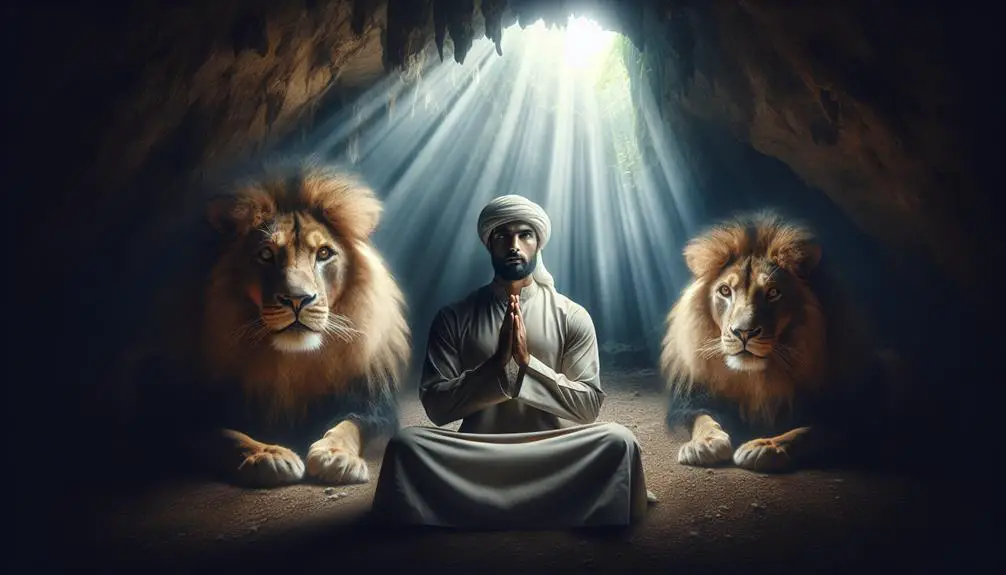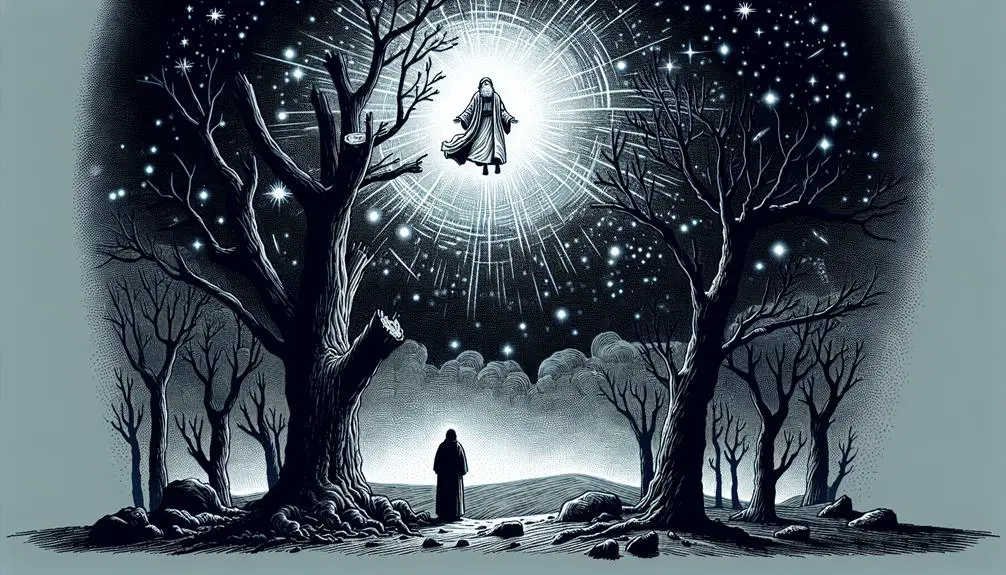Learn about biblical figures who showcased immense faith in adversity, from Abraham's sacrifice to Esther's courage, and discover their inspiring stories.

Who Had Great Faith in the Bible
Faith can move mountains, and when you look into the Bible, you'll find individuals whose faith did just that in their times of trial. Consider Abraham, who was willing to sacrifice his son Isaac, proving his unwavering faith, or Esther, who bravely approached the king to save her people, demonstrating her courageous belief.
Then there's Daniel, who survived a den of lions, and Job, who maintained his faith through immense suffering. Mary's acceptance of a divine role and Peter's journey from denial to foundational faith highlight the transformative power of belief.
Each story leaves us pondering how faith manifests in times of adversity and what lessons we can draw from these examples for our own lives.
Key Takeaways
- Abraham demonstrated great faith by trusting in God's promises, even when asked to sacrifice his son, Isaac.
- Esther showed remarkable faith through her courageous decision to risk her life for her people, navigating complex royal and gender dynamics.
- Daniel's unwavering devotion, even when faced with death in a lions' den, exemplifies the power of faith in overcoming adversity.
- Peter's journey from doubt to becoming a foundational figure in Christianity highlights the transformative power of faith and redemption.
Abraham's Ultimate Test

Abraham's ultimate test came when he was instructed to sacrifice his son, Isaac, showcasing a profound act of faith that has been analyzed and debated by scholars for centuries. This narrative hinges on the intricate balance between sacrifice symbolism and divine promises, inviting a deeper exploration of faith's nuances. You're venturing into a realm where the act of sacrifice transcends mere loss, embodying a profound testament to unwavering trust in divine will.
The symbolism of sacrifice in this context is layered, representing not just the willingness to relinquish what's dearly held but also a pivotal moment of covenantal faith. It's a demonstration of Abraham's trust in divine promises, despite the seeming paradox of being asked to sacrifice his promised son. This act challenges you to consider the depths of faith required to proceed with such a command, highlighting the complexity of divine-human relations.
Moreover, the narrative intricately weaves the concept of divine promises into its core, where the promise of progeny and blessings is juxtaposed against the command to sacrifice Isaac. This juxtaposition serves as a critical examination of faith's dynamics, where the fulfillment of divine promises is seen as contingent upon the believer's complete trust and obedience.
In analyzing Abraham's ultimate test, you're invited to reflect on the intricate relationship between sacrifice and divine promises. It's a narrative that doesn't just recount a historical event but also invites a deeper contemplation of faith's essence, challenging you to consider the lengths one might go to in demonstrating unwavering faith in the divine.
Esther's Courageous Stand

Transitioning from the narrative of Abraham's sacrifice, we now examine the story of Esther, which showcases her remarkable courage and strategic acumen in confronting a decree that threatened her people's existence. Esther's position as queen placed her in a unique position to effect change, yet her gender and minority status presented significant barriers in a patriarchal society. Her story is a compelling exploration of faith, identity, and the dynamics of power.
Esther's strategic approach to royal intervention underscores the complex interplay of gender dynamics within the narrative. Despite the risks, she leverages her position to advocate for her people, embodying a nuanced form of resistance. Here are four key aspects of her story that evoke deep emotion:
- The Risk of Royal Intervention: Esther's decision to approach the king without being summoned could have led to her death. Her courage in the face of such danger is profoundly moving.
- Navigating Gender Dynamics: Esther's story is a testament to her navigational skills within the constraints imposed by her gender, showcasing her ability to use the very dynamics that sought to limit her to her advantage.
- Strategic Acumen: Her methodical planning, including fasting and organizing prayer among her people, highlights her strategic mindset.
- The Triumph of Faith: Ultimately, Esther's faith-driven action not only saves her people but also brings about a reversal of fortune for her enemy, Haman.
Esther's narrative offers a rich analysis of royal intervention and gender dynamics, illustrating how faith and courage can lead to monumental shifts in the course of history.
Daniel in the Lion's Den

Moving from Esther's strategic brilliance, we now explore another profound biblical account of faith under trial: Daniel in the Lion's Den. This narrative, deeply embedded in the Judeo-Christian tradition, isn't just a tale of survival; it's a multifaceted exploration of faith, politics, and divine intervention.
Daniel's ordeal in the lion's den is precipitated by his unwavering devotion to his faith, a commitment that incurs the wrath of jealous rivals in the Babylonian court. They manipulate King Darius into issuing a decree that ultimately targets Daniel for his practice of praying to God, contravening the king's temporary edict that prayer should only be directed to him. Daniel's subsequent punishment, being thrown into a den of lions, serves as the ultimate test of faith.
The lion's symbolism in this context is twofold. Firstly, it represents the seemingly insurmountable challenges and dangers that believers may face in their spiritual journey. Secondly, it underscores the power and sovereignty of God, who's capable of taming even the most ferocious creatures. The divine intervention that saves Daniel—shutting the lions' mouths—reinforces the notion that unwavering faith in God can deliver believers from the jaws of death.
This episode in Daniel's life highlights the tension between earthly authority and divine mandate. It serves as a powerful testament to the virtue of steadfast faith in the face of persecution and mortal danger. Daniel's experience in the lion's den becomes a symbol of divine protection and vindication for those who remain faithful.
The Persistence of Job

In the biblical narrative, the story of Job stands out as a profound examination of faith's endurance amidst unparalleled suffering and trials. Job's resilience becomes a focal point, illustrating not just the capacity for human endurance, but also the complex interplay between divine sovereignty and human suffering. This story compels you to contemplate the purpose of suffering and the nature of unwavering faith.
Job's experience with loss and pain isn't just a tale of personal tragedy but a broader lesson on the dynamics of faith under pressure. Consider the following aspects of Job's story to understand the depth of his faith:
- Loss of Wealth and Health: Job loses everything he has, including his health. Yet, his faith, though tested, doesn't falter. This tests his resilience and challenges the notion that faith is only present when life is prosperous.
- Social Isolation: His friends and family turn against him, offering criticism instead of comfort. This isolation tests the limits of Job's endurance and the integrity of his faith.
- Questioning and Wrestling with God: Job's frank dialogue with God highlights the authenticity of his faith. He doesn't shy away from expressing his confusion and distress, showcasing a relationship with God that's deeply personal and real.
- Restoration and Insight: Job's eventual restoration, both materially and spiritually, isn't the climax of his story. Rather, it's his profound insight into the nature of suffering and the realization that some questions remain unanswered.
Through Job's story, you're invited to explore the nuanced understanding that suffering's purpose isn't always for us to see immediately. Job's resilience teaches that faith can survive, and even thrive, through the darkest of times.
Mary's Unwavering Belief

Mary's unwavering belief, amidst profound uncertainty, showcases a remarkable depth of faith and trust in divine promises. The narrative of the Virgin birth, central to Christian theology, underscores this faith uniquely. You're introduced to a young Mary, who, despite the societal implications of an unwed pregnancy, accepts her role in a divine plan with humility and conviction. This acceptance follows an Angelic visitation, a moment that would pivot her life into uncharted territories.
Analyzing this episode, it's crucial to contextualize Mary's reaction. In a society where her predicament could have led to severe social ostracization, her immediate and unwavering 'yes' to the angel Gabriel's announcement reflects not just passive acceptance but active faith. This faith isn't blind; it's rooted in a profound understanding of her role in a larger divine narrative. Mary's belief transcends the fear of personal consequence, embodying a trust in God's promises that's both profound and instructive.
Moreover, Mary's faith isn't static; it evolves. As you delve deeper into her story, you observe a mother who ponders and treasures the unfolding events of her son's life, even when they defy human logic. From the manger to the cross, her faith doesn't waver.
Peter's Journey of Faith

While Mary's story epitomizes a serene acceptance of divine will, Peter's journey of faith is marked by a dynamic evolution from doubt to unwavering belief. You observe Peter transitioning from a humble fisherman to a cornerstone of early Christianity, a transformation punctuated by moments of profound vulnerability and divine revelation.
Peter's journey can be encapsulated through key episodes that evoke deep emotional responses:
- Water Walking: When you see Peter stepping out of the boat onto the stormy sea, his initial faith enables him to walk on water towards Jesus. However, as doubt seizes him, he begins to sink, only to be saved by Jesus. This moment underscores the fragility of faith amidst fear and the omnipresent support of the divine.
- The Transfiguration: Witnessing Jesus transfigured alongside Moses and Elijah, you're reminded of Peter's recognition of Jesus' divinity. Yet, his offer to build shelters for each reveals his misunderstanding of Jesus' mission, illustrating the journey from misinterpretation to enlightenment.
- Rooster Crowing: Perhaps the most poignant moment is Peter's denial of Jesus thrice before the rooster crows, a fulfillment of Jesus' prophecy. You feel the depth of Peter's despair and remorse, a turning point that catalyzes his unwavering commitment to his faith and mission.
- Pentecost: Finally, you see Peter transformed, boldly proclaiming the gospel at Pentecost. Filled with the Holy Spirit, he becomes a pivotal figure in spreading Christianity, demonstrating the power of redemption and the strength of faith forged through adversity.
Peter's journey from doubt to conviction serves as a powerful narrative on the complexity of faith, resilience, and redemption.
Frequently Asked Questions
How Do Modern Scholars Interpret the Concept of Faith in Contexts Outside the Judeo-Christian Tradition, and What Parallels Can Be Found in Other Religious Texts?
You're diving into how scholars view faith across various beliefs, focusing on comparative mythology and faith symbolism. They find common threads in diverse religious texts, revealing shared human experiences and values.
In Psychological Terms, How Does the Concept of Faith Contribute to an Individual's Resilience and Coping Mechanisms in the Face of Adversity?
In psychological terms, faith significantly boosts your resilience and coping mechanisms during tough times. It's not just a belief; it has a neurological impact that enhances your emotional intelligence, helping you manage stress better.
Are There Any Archaeological Findings or Historical Evidence That Support the Biblical Narratives of Characters Known for Their Great Faith?
Diving into the depths of history, you'll find that archaeological discoveries indeed illuminate the narratives of ancient texts. Faithful artifacts and an understanding of Scriptural geography provide tangible connections to these stories.
While not all tales are directly supported by physical evidence, findings such as inscriptions and ancient city ruins lend credibility to the historical context of these narratives.
Analyzing these elements, you'll uncover layers of truth intertwined with the legendary faith of these figures.
How Has the Portrayal of Faith in These Biblical Stories Influenced Contemporary Legal and Ethical Frameworks, Especially in Multicultural and Secular Societies?
You'll find that the portrayal of faith in historical narratives shapes contemporary legal precedents and ethical dilemmas, particularly in multicultural and secular societies.
These stories offer foundational principles that influence modern legal systems and ethical frameworks, guiding decisions in complex cases. They serve as a moral compass, contributing to the resolution of conflicts and the establishment of laws that reflect a blend of diverse cultural and religious values.
What Role Does Gender Play in the Biblical Narratives of Faith, and How Have Interpretations of These Roles Evolved in Modern Feminist Theological Discourse?
In the tapestry of biblical narratives, gender plays a pivotal role, often entangled with patriarchal interpretations. However, modern feminist re-readings have begun to unravel these threads, offering new perspectives that challenge traditional views.
This evolution in interpretation not only enriches our understanding of these ancient texts but also reflects broader shifts towards gender equality in theological discourse, providing a fresh lens through which to analyze and appreciate these stories.
Conclusion
In the tapestry of biblical narratives, you, the reader, are invited to traverse the allegorical landscape where faith is both shield and beacon.
Like Abraham, Esther, Daniel, Job, Mary, and Peter, you're called to navigate the storms of doubt with a steadfast heart.
These stories, more than ancient texts, serve as mirrors reflecting the enduring human quest for belief amidst trials.
Analytically, they underscore the timeless virtue of faith, urging us to look beyond the seen to the unseen, guiding us towards an unwavering trust in the divine narrative of our own lives.



Sign up